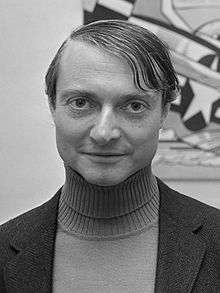Yellow and Green Brushstrokes
| Yellow and Green Brushstrokes | |
|---|---|
 | |
| Artist | Roy Lichtenstein |
| Year | 1966 |
| Medium | Oil and Magna on canvas |
| Movement | Pop art |
| Dimensions | 213.4 cm × 457.2 cm (84 in × 180 in) |
| Location | Museum für Moderne Kunst, Frankfurt |
Yellow and Green Brushstrokes is a 1966 oil and Magna on canvas pop art painting by Roy Lichtenstein. It is part of the Brushstrokes series of artworks that includes several paintings and sculptures. It is located at the Museum für Moderne Kunst in Frankfurt, Germany. As with all of his Brushstrokes works, it is in part a satirical response to the gestural painting of Abstract Expressionism.
Background

Yellow and Green Brushstrokes is located at the Museum für Moderne Kunst in Frankfurt, Germany. The museum acquired the work from the collection of Karl Ströher in 1981.[1] The source for the entire Brushstrokes series was Charlton Comics' Strange Suspense Stories 72 (October 1964) by Dick Giordano.[2][3]
According to the Lichtenstein Foundation, Lichtenstein produced two distinct 1966 oil and Magna on canvases by the title Yellow and Green Brushstrokes.[4] The second one is smaller at 36 x 68 inches (91.4 x 172.7 cm). It involved much straighter brushstrokes.[5]
The painting depicts two brushstrokes magnified to cover the entire vast canvas. This is one of several such Brushstrokes series representations that seem "absurd".[6]
Details

Measuring 213.4 cm × 457.2 cm (84 in × 180 in), Yellow and Green Brushstrokes is regarded as quite notable for its ability to imply perceptible movement although his works is limited to a single image on a canvas with finite space. The movement is considered similar to the explosive actions evident in earlier works such as Whaam! and As I Opened Fire.[7] He uses overlapping forms rather than a single form or distinct adjacent forms, which seems to create a more dynamic feel to the shallow space.[8] However, since Lichtenstein does not uses shading or contrast, the monochromatic strokes with just bold black outlines are void of certain elements of depth.[9] Big Painting No. 6 and Yellow and Green Brushstrokes go one step further in terms of canvas size and dynamic activity that was presented earlier in Little Big Painting.[10] At 15 feet (4.57 m) wide, the magnitude of the work is exceptional for Lichtenstein.[11] Edward F. Fry described the work in the October 1969 ARTnews as "The heroic brushstroke of Abstract-Expressionism mocked by objective treatment in comic-strip idiom".[12] This work is regarded as a rare example of Lichtenstein performing as a "virtuoso painter" and using "bravura technique".[13]
See also
Notes
- ↑ "Yellow and Green Brushstrokes, 1966". Museum für Moderne Kunst. Retrieved May 14, 2012.
- ↑ Foster, Hal (2010). Francis, Mark, ed. Pop. Phaidon. p. 150. ISBN 978-0-7148-5663-6.
- ↑ "Strange Suspense Stories #72". Lichtenstein Foundation. Retrieved May 25, 2012.
- ↑ "String: Yellow and Green Brushstrokes". Lichtenstein Foundation. Retrieved May 14, 2012.
- ↑ "Yellow and Green Brushstrokes". Lichtenstein Foundation. Retrieved May 14, 2012.
- ↑ Foster, Hal (2010). Francis, Mark, ed. Pop. Phaidon. p. 150. ISBN 978-0-7148-5663-6.
- ↑ Waldman. p. 157.
Lichtenstein's ability to convey the illusion of movement while containing his forms within the picture plane is particularly striking in Yellow and Green Brushstrokes [...]
Missing or empty|title=(help) - ↑ Waldman. p. 161. Missing or empty
|title=(help) - ↑ Waldman. p. 161. Missing or empty
|title=(help) - ↑ Waldman. p. 161. Missing or empty
|title=(help) - ↑ Coplans, John, ed. (1972). Roy Lichtenstein. Praeger Publishers. p. 25.
True, there are large paintings—...as well as a large brushstroke (Yellow and Green Brushstrokes, 1966)...—but on the whole, he only works at mural scale when the subjects are larger.
- ↑ Fry, Edward F. "Inside the Trojan Horse". ARTnews. 68 (6). p. 36.
- ↑ Waldman. p. 271. Missing or empty
|title=(help)
References
- Waldman, Diane (1993). Roy Lichtenstein. Solomon R. Guggenheim Museum. ISBN 0-89207-108-7.